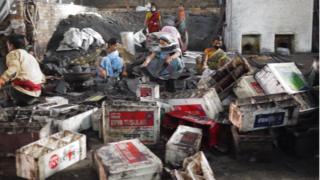
Image copyright
Pure Earth
Unregulated recycling of lead-acid batteries is the main cause of lead poisoning
One in three children could have been exposed to poisonous lead, potentially causing irreversible harm, research into the global risk of exposure has found.
Unicef and Pure Earth estimate around 800 million children might be affected, with most in low and middle-income countries.
South Asia accounts for almost half the global total.
Poorly recycled lead batteries, e-waste, mining and paints are the main sources of poisoning, the report says.
Vehicle batteries prime culprit
The report’s authors say their findings were mainly based on data from the Institute of Health Metrics and Evaluation (IHME) at the University of Washington, which obtained results of blood tests on tens of thousands of children across the globe.
IHME publishes the research tool, the Global Burden of Disease
“Vehicles in low and middle-income countries have tripled since 2000 and that has led to a graphic rise in lead acid battery recycling, often in an unsafe way,” Dr Nicholas Rees, one of the report’s authors, told the BBC.
About 85% of all the lead used in the world goes to produce lead-acid batteries, and the vast majority comes from recycled car batteries.
“As a result, as much as half of the used lead-acid batteries end up in the informal economy,” the report says.
“Unregulated and often illegal recycling operations break open battery cases, spilling acid and lead dust onto the ground, and [there is] smelt lead in open-air furnaces that spew toxic fumes and dust that contaminate surrounding neighbourhoods.”
Image copyright
Pure Earth
Lead dust from improper recycling factories can pollute the air of the entire neighbourhood
Why are children vulnerable?
Experts say children’s intake of food, liquid and air is up to five times more than that of adults, if the body-weight ratio is compared.
“That means they can absorb more of this potent neurotoxin if it has leached into the soil and water or has spread in the air where the child is,” says the report.
It adds that babies and children under five are at high risk, because their brains can be damaged even before they get to fully develop, leading to lifelong neurological, cognitive and physical impairment.
“Lead is a potent neurotoxin that, with even low-level lead exposure, is associated with a reduction in IQ scores, shortened attention spans, and potentially violent – and even criminal – behaviour later in life.”
The report says India has the largest number – more than 275 million children – with blood lead levels of more than five micrograms per decilitre.
Image copyright
Pure Earth
Lead can also leach into soil and groundwater
That level, according to the US Centre for Disease Control and Prevention (CDC), requires action.
Children living at or near lead acid battery recycling workshops in India, have been found to have lead levels up to 190 micrograms per decilitre, according to Dr. Abbas Mahdi, head of the department of bio-chemistry at King George’s Medical University in India’s Uttar Pradesh state.
“Our children are also exposed to other contamination like some spices and herbal medicines that have lead as a preservative and colour enhancer.”

















